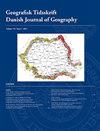丹麦城市规划中彰显品牌的高层建筑变化
IF 0.8
4区 社会学
Q4 ENVIRONMENTAL STUDIES
Geografisk Tidsskrift-Danish Journal of Geography
Pub Date : 2020-07-02
DOI:10.1080/00167223.2020.1816484
引用次数: 0
摘要
近几十年来,我们见证了丹麦通过引入零售规划进一步保护中心城市核心的举措。最近的立法变化通过自由党政府提出并于2017年由丹麦议会通过的计划改革,大大改变了这些原则。立法的变化符合丹麦自2000年代中期以来空间规划自由化的长期趋势。2019年6月4日,开发商宣布暂停建设高层塔楼及其配套的购物区。这是Brande镇外的一个项目,由于其激进的外观在建筑和城市规划界引起了轰动。在2017年规划改革之前,由于丹麦规划法中的零售规划章节,这样的项目是不可能的。本文的目的是揭示布兰德的项目,立法的变化,使其成为可能,以及它为丹麦城市规划设定的优先级。规划立法和实践的变化与丹麦城市规划的历史背景有关,规划原则的变化是在国际和理论背景下设定的。本文章由计算机程序翻译,如有差异,请以英文原文为准。
Highrise in Brande—highlighting change in Danish urban planning
ABSTRACT In recent decades, we have witnessed a move towards a further protection of central urban cores through introduction of retail planning in Denmark. Recent changes in legislation have significantly changed these principles through a planning reform as proposed by the liberal government and adopted by Danish parliament in 2017. The change in legislation fits with a longer trend of liberalization of spatial planning in Denmark since the mid-2000s. 4th of June 2019 it was announced that the building of a high- rise tower and accompanying shopping district was put on hold by the developer. A project proposed for outside the town of Brande, which due to its radical appearance had caused a stir in architectural- and urban planning communities. Before the 2017 planning reform, such a project would be impossible due to the retail planning sections in the Danish planning act. This purpose of this article is to unfold the project in Brande, the change in legislation, which made it possible, and the precedence it sets for Danish urban planning. The change in planning legislation and practice is contextualized with a historical background for Danish urban planning, and the change in planning principles is set in an international- and theoretical context.
求助全文
通过发布文献求助,成功后即可免费获取论文全文。
去求助
来源期刊
CiteScore
5.20
自引率
0.00%
发文量
5
期刊介绍:
DJG is an interdisciplinary, international journal that publishes peer reviewed research articles on all aspects of geography. Coverage includes such topics as human geography, physical geography, human-environment interactions, Earth Observation, and Geographical Information Science. DJG also welcomes articles which address geographical perspectives of e.g. environmental studies, development studies, planning, landscape ecology and sustainability science. In addition to full-length papers, DJG publishes research notes. The journal has two annual issues. Authors from all parts of the world working within geography or related fields are invited to publish their research in the journal.

 求助内容:
求助内容: 应助结果提醒方式:
应助结果提醒方式:


